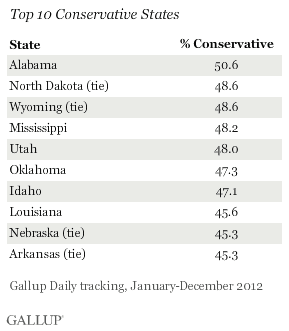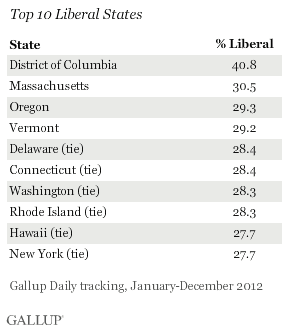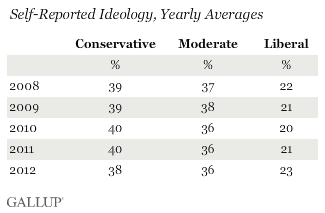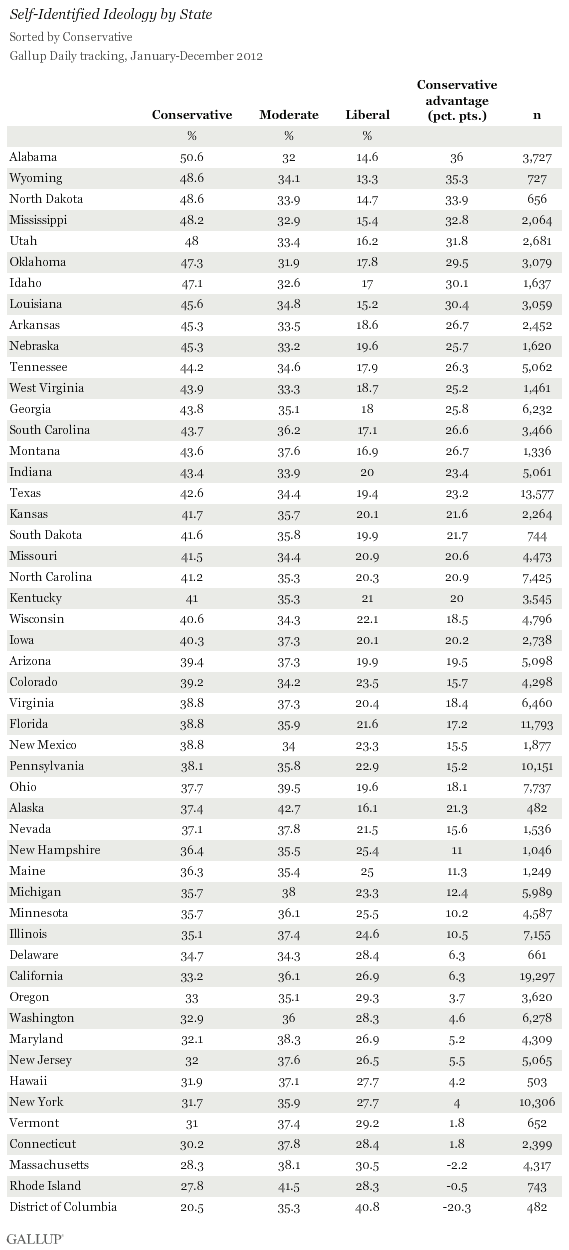PRINCETON, NJ -- Alabama, North Dakota, and Wyoming were the most conservative states in the union in 2012, with between 49% and 50% of residents in each identifying their ideology as conservative. Residents of the District of Columbia were by far the most likely to identify as liberal (41%), followed by Massachusetts (31%), Oregon, and Vermont (each at 29% liberal).


The distribution of ideology in 2012 generally reflects the familiar "blue state," "red state" patterns that define the political geography of today's modern America.
The top 10 conservative states are all red states that vote reliably Republican in national elections, all located in the nation's Southern, Midwestern, and Mountain West regions. These include (in addition to Alabama, North Dakota, and Wyoming) Mississippi, Utah, Oklahoma, Idaho, Louisiana, Nebraska, and Arkansas. There is not, however, a perfect correlation between ideology and party. Three of the 10 most Republican states -- Kansas, Montana, and Alaska -- do not rank among the most conservative states. And Mississippi, Louisiana, and Arkansas rank in the top 10 conservative states but not the 10 most Republican.
The top 10 liberal states -- Delaware, Connecticut, Washington state, Rhode Island, Hawaii, and New York, in addition to D.C., Massachusetts, Oregon, and Vermont -- are all reliably Democratic voting states. All but Vermont and D.C. are on one of the two coasts, or -- in Hawaii's case -- surrounded by the Pacific Ocean. There is somewhat more accordance between the most liberal and most Democratic states. Only Illinois and Maryland rank among the most Democratic but not the most liberal. Oregon and Washington state rank among the 10 most liberal states but not the 10 most Democratic.
The full results by state appear on page 2. The accompanying map displays the "conservative advantage," defined as the percentage conservative minus the percentage liberal in each state.
Alaska Has the Highest Percentage of Moderates
The distribution of moderates across the states is not highly related to the basic partisanship of the states. The state with the most moderates -- Alaska -- typically votes Republican and has a high Republican identification. The other two states with the highest percentage of moderate residents are Rhode Island (a blue state) and Ohio (a swing, competitive state).

Overall, most states have a similar percentage of residents who consider themselves moderate -- with an 11-percentage-point range from the highest (43% in Alaska) to the lowest (32% in Oklahoma) states.
By contrast, the range in conservatism across the states is 30 points (from Alabama's 51% conservative to D.C.'s 21%; or a range of 23 points with D.C. excluded, given Rhode Island's 28% conservative percentage), while the liberal percentage range is 28 points -- from D.C.'s 41% to Wyoming's 13%, or 18 points with D.C. excluded, taking into account Massachusetts' 31% liberal percentage.
Americans Slightly More Liberal and Less Conservative Than in 2011
Overall, Americans in 2012 remained slightly more likely to identify as conservative (38%) than as moderate (36%) or as liberal (23%), a pattern that reflects the general consistency in ideological self-reports over recent years.
More broadly, the percentage of Americans identifying with each of these ideological labels has been remarkably consistent since Gallup tracking began in 2008. The range of each has varied by a maximum of only three points.

Mississippi Becomes More Liberal, but Only on Relative Basis
Most of the ideological patterns within states stayed fairly constant from 2011 to 2012. The largest changes in favor of conservatism came in North Dakota, whose residents became five points more likely to be conservative, and Alaska (four points more conservative). Four states became at least five points more likely to be liberal, including Delaware (nine points more liberal), and Vermont, Minnesota, and Mississippi -- all of which became five points more liberal. Of course, even with its liberal "gains," Mississippi's current 15% liberal percentage is the fifth lowest of any state; last year, Mississippi's 11% liberal was the lowest of any of the 50 states and the District of Columbia.
Bottom Line
America has become a slightly more liberal and a slightly less conservative nation than it was in 2011 -- based on residents' self-reports of their ideology -- but conservatives still outnumber both moderates and liberals. The geographic dispersion of ideology across the states follows what are by now familiar lines of political demarcation. The most conservative states are in the South, Midwest, and Mountain West, while the most liberal are on the East or the West Coast.
More than half of Alabama residents identified as conservative last year, compared with only about a fifth in the District of Columbia and less than 30% in Rhode Island and Massachusetts. And while there are not as many self-defined liberals in the country overall, the range is still substantial, from 41% in D.C. and 31% in Massachusetts, down to 13% in Wyoming.
These three ideological labels are quite broad, and as such, the precise implications of what it means to define oneself as conservative or moderate or liberal are not always clear. In 2012, 69% of conservatives either identified as Republican or leaned Republican, meaning that three in 10 did not follow the predicted partisan pattern. Seventy-eight percent of liberals identified as or leaned Democratic. Additionally, Americans can be conservative on one set of economic or social issues while being liberal on others. Still, these broad labels are useful indicators of the general ideological camps into which Americans place themselves, and clearly underscore the substantial variance in political and ideological composition of the U.S. states.
Gallup's "State of the States" series reveals state-by-state differences on political, economic, and well-being measures Gallup tracks each day. New stories based on full-year 2012 data will be released throughout the month of February.
Survey Methods
Results are based on telephone interviews conducted as part of Gallup Daily tracking Jan. 1-Dec. 31, 2012, with a random sample of 211,972 adults, aged 18 and older, living in all 50 U.S. states and the District of Columbia.
For results based on the total sample of national adults, one can say with 95% confidence that the maximum margin of sampling error is ±1 percentage point.
Margins of error for individual states are no greater than ±6 percentage points, and are ±3 percentage points in most states. The margin of error for the District of Columbia is ±6 percentage points.
Interviews are conducted with respondents on landline telephones and cellular phones, with interviews conducted in Spanish for respondents who are primarily Spanish-speaking. Each national sample includes a minimum quota of 400 cell phone respondents and 600 landline respondents per 1,000 national adults, with additional minimum quotas among landline respondents by region. Landline telephone numbers are chosen at random among listed telephone numbers. Cell phones numbers are selected using random digit dial methods. Landline respondents are chosen at random within each household on the basis of which member had the most recent birthday.
State samples are weighted to be representative of the state's adult population by gender, age, race, Hispanic ethnicity, and education based on the March 2012 Current Population Survey. All reported margins of sampling error include the computed design effects for weighting.
In addition to sampling error, question wording and practical difficulties in conducting surveys can introduce error or bias into the findings of public opinion polls.
For more details on Gallup's polling methodology, visit www.gallup.com.

